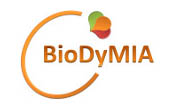2015 (07): "Immiscible biodegradable polymer blends : influence of the morphology on the control of the release of active substances or models" (Thesis by Fadi KHALIL)
Thesis defended on September, 7th, 2015
Read the thesis online
Thesis supervisor: Pascal Degraeve (BioDyMIA, Lyon1)
Co-supervisors: Sophie Galland, Catherine Joly.
Subject presentation :
The bio-protection or bio-preservation of food (or health products) involves the controlled migration of antimicrobial entities released from host polymers previously formulated, this in contrast to strategies for formulating food in the presence of "Conservatives". This migration phenomenon is widely studied / modeled in the health context relating to contamination of food by the additives initially present in packaging polymers. Empirical statistical models and transport laws (based on Fick's laws) have enabled the development of mathematical models or dedicated servers allowing, if not modeling the transfer, the dimensioning of migration experiences. However, certain fields remain little explored. The case of additives with a molecular weight greater than 1000 g / mol, or the activation of transport phenomena by humidity especially in the field of polar polymers often protected during conventional food contact. The purpose of this thesis work is to understand the transport phenomena through a set of model migrants of variable molecular masses and chemical structures allowing to diversify the migrant / matrix interactions: the search for such homologous series (in molar mass and / or interaction parameters) is a first research effort. The selected polar host polymers do not make it possible to achieve the usage properties required for a packaging material (mechanical properties in particular and their variability according to their hydration state). Mixtures of incompatible polymers are used to overcome the deficiencies of polar polymers and to study the influence of the retained morphology (ies) on the diffusion properties in the so-called co-continuity zone partial or total where the diffusional behaviors can present particularities of interest with also a release for example triggered by water.
In an applicative way, the purpose of this work will relate to the realization of a real system (s) with transport of selected antimicrobial entity (ie bacteriocin such as Nisin), whose transport could be activated in an original way by the water provided by the conditioned food product. Antimicrobial activity can be assessed in this application context.
Methodology used:
Part 1: Making thermodynamically incompatible TPS / PBS mixtures by melt
Part 2: Morphology of mixtures by selective extraction of the phases in the presence of a solvent medium, sorption of volatile molecules, desorption of molecules marking the starchy phase. Selection of mixtures of partial or total co-continuous morphologies.
Part 3: Selection of migrants with sharing coefficients favorable to the TPS phase. Realization of ternary TPS / PBS / migrant formulations alone or in mixture.
Part 4: Impact of the morphology of polymer blends on the transport of selected migrants in simulants or model food matrices - activation by water.
Part 5: Application to the transport of bacteriocin and antimicrobial activity of model films.
Technical means :
- Single screw laboratory extrusion or internal mixer (brabender type);
- SEM, Soxhlet extractors, water sorption,
- Desorption and / or migration assemblies of compounds of interest (spectroscopic and chromatographic methods)
Project partners:
- Technical Center for the Conservation of Agricultural Products (CTCPA) -Bourg en Bresse
- IMP-UJM - Ingénierie des Matériaux Polymères



 en
en fr
fr